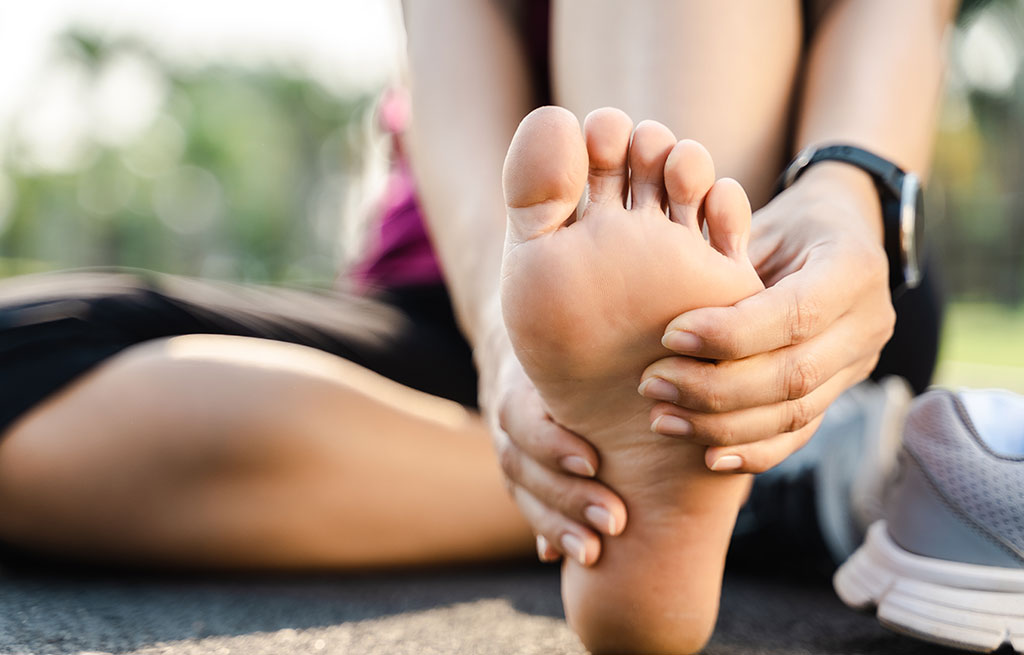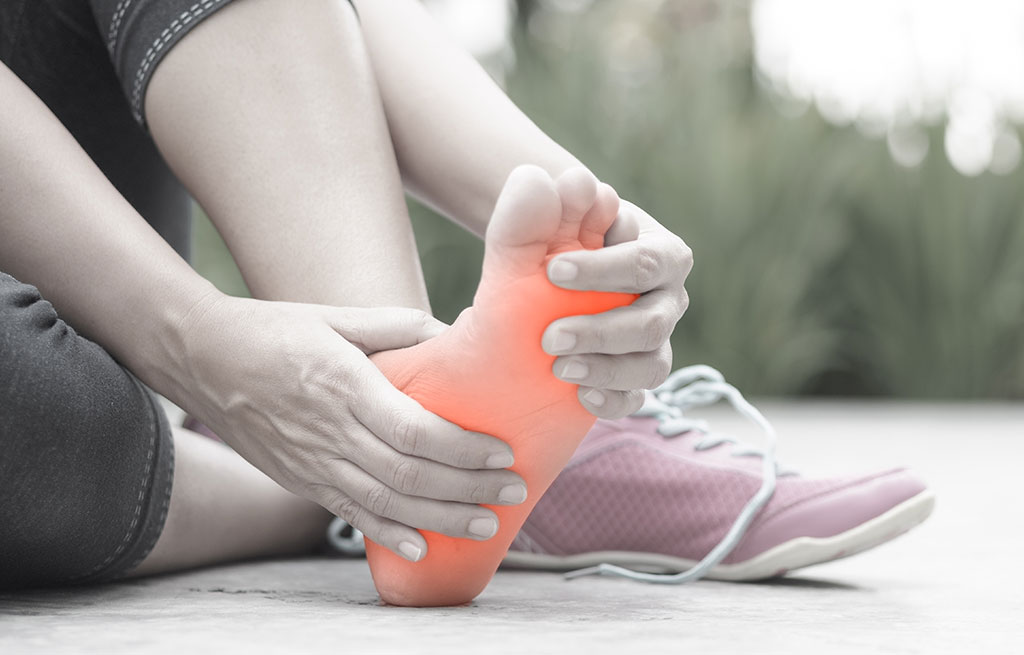According to two podiatrists and an orthopedic physical therapist
When your feet are sore, you can feel miserable: tired, cranky, and uncomfortable. Many lifestyle habits can cause feet to ache, including being on your feet all day, exercise, and choice in footwear. Bruce Pinker, DPM, a foot and ankle specialist, explains: "Soreness commonly occurs in the ball of the foot and in the heel region." He adds that two conditions, metatarsalgia/bursitis and plantar fasciitis, both of which involve inflammation of tissue and nerves, are quite common. "These conditions can arise from increased stress placed upon the feet, especially if wearing high-heeled shoes or flip-flops or flats," says Pinker. Although there are many things you can do at home to alleviate sore feet, there comes a time when medical treatment is advised.

"If the soreness does not resolve after three days of stretching and soaking, one should seek the attention of a podiatrist," explains Pinker. "Feet are not supposed to hurt, and the pain can be a sign of a serious condition, such as a fractured or broken bone, a ligament sprain, a tendon strain, or even a bone tumor." Additionally, any tingling or numbness, pain that keeps you up at night, or pain that causes you to limp requires a medical diagnosis.
If however, foot discomfort is low-grade yet chronic, there are several things you can do to feel better fast. Ahead, podiatrists and orthopedic specialists offer home remedies for sore feet.
MEET THE EXPERTS
- Ashley Lee, DMP, is a podiatrist at Northern Illinois Foot & Ankle Specialists. She previously served as the chief of podiatric surgery at Northwest Community Hospital and is double board-certified with the American College of Foot and Ankle Surgeons in foot surgery as well as ankle and rearfoot reconstruction surgery.
- Bruce Pinker, DPM, AACFAS, FAPWCA, DABPM, FACPM, is a foot and ankle surgeon who is board-certified by the American Board of Podiatric Medicine.
- Jerry Yoo, PT, DPT, CSCS, is a doctor of physiotherapy that specializes in orthopedic and sports clientele.
[1 of 12] Soak Feet in Epsom Salts
A tried-and-true remedy for sore feet is a warm soak in epsom salts. According to Lee, there's no evidence that epsom salts, which adds a boost of magnesium and sulfate to water, is any more effective than warm water alone. However, she says that epsom salts do make the bathwater feel "softer," which can be very soothing.
[2 of 12] Try a Quick Contrast Bath
Yoo suggests running a quick contrast bath—"hot water for five minutes, cold water for five minutes, hot water for five minutes"—to provide relief from sore feet. "The temperature change allows for contraction and dilation of the vessels in your feet," he says, which can remedy discomfort and ease pain.

Stretching feet and toes is crucial to relieving sore feet and optimizing overall health, because, according to Pinker, "soreness in feet is usually a sign of inflammation." Pinker advises you stretch your feet and toes early in the morning, as well as part of your warm-up routine before exercise.
Yoo says you should be constantly stretching your feet in little bursts, all day long. "Ankle-foot-toe mobility works for sore feet prevention. Throughout the day, I'll take a few minutes to stretch out my toes in all directions and move my ankle and foot in all directions," he says. "This usually minimizes the incidence of soreness or stiffness of my feet. I also remove my shoes when I do these exercises to give my feet and toes a chance to breathe!"
When it comes to cracking your toes, Lee explains all that does is release a "buildup of nitrogen in the joints." It's not harmful she says, especially if toes pop when being stretched. Although she adds that some patients swear it makes them feel better, Lee advises to flex your foot downward for more intensive relief.
[4 of 12] Stretch Calves and Hamstrings
In addition to stretching your feet and toes, it's important to address other parts of your limbs to relieve foot pain. "In physical therapy," explains Lee, "we never just focus on the foot, as pain is not isolated." She says the calf consists of three separate muscles (the gastrocnemius, soleus, and plantaris) whose aponeuroses unite to form the Achilles tendon. "When that tendon is tight, the foot hurts," she says. Additionally, she recommends people give the hamstrings a good stretch, because, "everything is connected."
Foot rollers are highly effective to relieve foot pain, as they both stretch and massage the muscles in the feet at the same time. They are especially good "if you are prone to diagnoses like plantar fasciitis," says Yoo. However, there are some guidelines to foot rolling in order to maximize its efficacy and prevent further discomfort. "The key is to ease into using them," he says. "Start with three to five minutes at a time using light pressure, then gradually work your way into more pressure (applying more body weight). Actively using your toes while rolling is even more effective. That said, In the presence of acute pain or injury, this should be guided by a healthcare professional."
If you don't have a foot roller, Pinker suggests "rolling the foot over a frozen 20-ounce bottle of water or a tennis ball."
[6 of 12] Self-Massage with a Massage Gun
If professional foot massage or reflexology isn't an option at the moment, self-massage is a good alternative. Massage guns are ultra popular, as they deliver powerful pressure and allow you to tailor sensations. Lee suggests starting on the lowest setting and the flat head (as opposed to the bullet head, which gives an even deeper massage). Work your way up to higher settings. "If it hurts," she says, "you're doing it wrong."
[7 of 12] Wear Compression Boots or Socks
Compression socks and boots can really work to address inflammation in your feet and ankles. "I personally use compression boots by Normatec, especially on days when I'm on my feet all day from work or athletics. Compression boots help to minimize any pooling of fluid that make your feet or lower legs swell and your feet get sore from the forces of gravity during the day,"
[8 of 12] Use an Insertable Insole
Lee says using an over-the-counter insole can be effective in relieving "fatigue in the arches." Not only does the foot have multiple arches, each person's anatomy is different. In order to maximize comfort, buy footwear to support the type of foot arch you have: low, medium, or high.
[9 of 12] Go Barefoot
When possible, go barefoot, as this practice can be amazing for your feet. Yoo advises, "Unless there's an injury that makes walking barefoot difficult, you've just run a race and the bottom of your feet have become tender, or you're walking outdoors, I typically favor bare feet over donning supportive footwear when not exercising." He adds, "As humans, we've become so used to wearing footwear, day in and day out, that our feet have become less adaptive to varied surfaces over time. Walking barefoot gives your brain much better input about your immediate environment and can even help with balance."
[10 of 12] Apply Heat
Unless your foot discomfort results from surgery or injury (meaning it's acute), you always treat chronic pain with heat. "With heat, you'll see more of an improvement [over ice] as it dilates the blood vessels and relaxes the foot," explains Lee. For even deeper penetration, consider using an infrared heating pad or device.
[11 of 12] Apply a CBD Topical
Lee says oral CBD products can be hit or miss with patients looking to alleviate foot pain. "When taken orally, CBD can make you tired," she explains, adding that CBD has a relaxing effect on the system. She advocates using a topical CBD salve or roll-on to circumvent this issue. "Treating the entire foot with CBD can get expensive, so it's better for focal foot pain."
[12 of 12] Apply a Transdermal Gel
Yoo typically doesn't recommend taking an over-the-counter anti-inflammatory for foot pain. "I usually don't advise unless I've checked in with their physician to make sure there aren't any other meds that might have an adverse response with over-the-counter anti-inflams," he says.
As as alternative, Lee suggests applying a transdermal non-steroidal anti-inflammatory drug (NSAID), called diclofenac. This medicine has only recently become available without a prescription and is now available over-the-counter. Transdermal application bypasses the GI system, and lets you treat the pain focally.